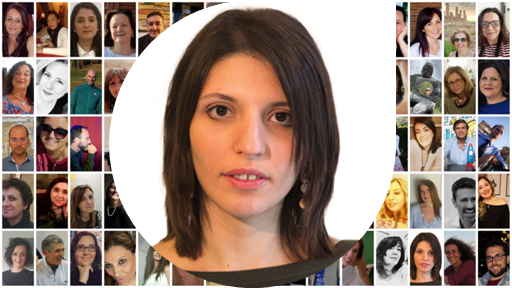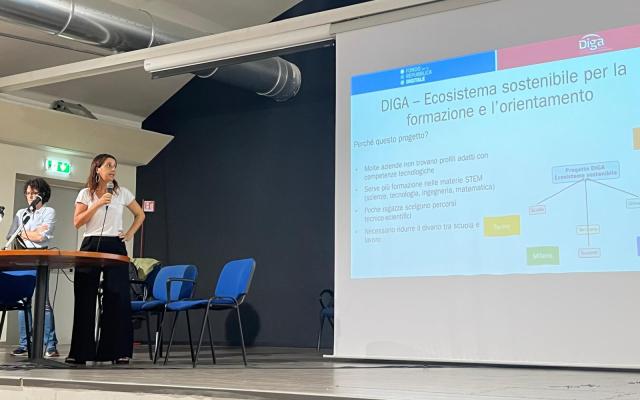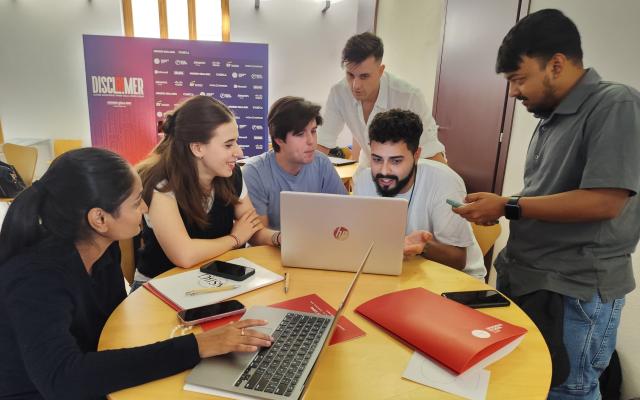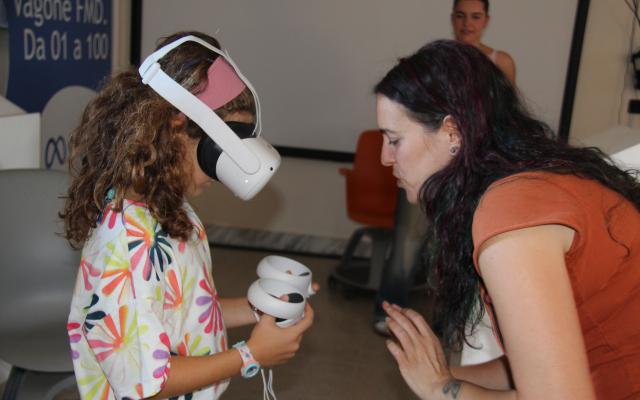This is our third weekly instalment of interviews with teachers in Project “Our School” who we have described as i-Teachers, inclusion teachers, who work day in and day out to make sure that no one is left behind [see news: Our School].
Today, a short video and an interview with Ilaria Gaudiello will introduce us to Kim Commisso, consultant, coach and professor of integrated didactics.
 Kim Commisso is a consultant, coach and professor of integrated didactics (physical and digital environments). She works on the development of digital skills, collaborating with schools and companies on project development, training and management with a focus on methodological-didactic aspects. She teaches in various professional institutes with a preference for a didactic approach that focuses on communication and digital information. She develops tools and exercises to use the web in innovative manners in her lessons.
Kim Commisso is a consultant, coach and professor of integrated didactics (physical and digital environments). She works on the development of digital skills, collaborating with schools and companies on project development, training and management with a focus on methodological-didactic aspects. She teaches in various professional institutes with a preference for a didactic approach that focuses on communication and digital information. She develops tools and exercises to use the web in innovative manners in her lessons.

INTERVIEW
Kim, your passion for didactics with digital tools has opened up a wide range of opportunity for you. You work with schools, for companies, research centres and publishers. What does digital pedagogy have in common with all these sectors?
The question is interesting, but not very easy to answer! First of all, rather than digital pedagogy I would refer, more generally, to pedagogy in its ample etymological meaning as a discipline that studies problems related to education and training with the support of various other sciences [1], and I would add the many digital tools that have become a part of our daily lives. In this sense, what all these sectors have in common is the development of “directed” courses so that each of our students, adult or young, can achieve “educational success.” And whether this is new knowledge or the development of specific skills, even before holding a lesson, we, as teachers, must focus on our learners and understand how to help them improve. Naturally, this is independent from any age group or other category. Once we are cognizant of these priorities, digital tools can be conceived not only as a complementary tool to integrate textbooks and other tools, but also as a larger and more structured cognitive environment that can be used for learning and that we are well acquainted with as we use it every day. Thus, a plan based on a thorough understanding of the learner (knowledge, limits and objectives) will allow us to devise lessons that are efficient both in terms of setting and learning impact.
Digital methodologies for pedagogy are evolving rapidly. How can teachers orient themselves amidst all these opportunities and methodologies? Which do you believe are the most important?
When one has the opportunity to work in various educational sectors, you often reach the conclusion that there really is nothing new, but just existing approaches seen from different perspectives, through the lens of our current context. And what is our context? It’s the one that has accelerated the entrance of technology into education, retrieved mobile and micro-learning as a fundamental didactic activity both in companies and at school. We are fully re-evaluating blended learning to allow integrated didactics. So, nothing new really, but we have a greater awareness of a fundamental fact: the proven efficiency of active didactic activities. An example of this is integral to the flipped classroom, an approach that is proving to be the winning one, especially if it is well planned. Teachers must prepare the materials for their students to generate an asynchronous mechanism of cognitive anticipation that will allow them to more efficiently capture the students’ attention, improving the understanding of the issues at hand. Stimuli may be provided through activities, questions or inclusive problems that allow the students to express what they know and know how to do, even if not in a systematic manner. Subsequently, the teacher will have to connect all the tesserae to allow their students to assimilate the lesson.
Today, didactic action has an amplified potential to involve, guide, and apply learning thanks to these new environments.
Finally, I believe that a good way to find one’s way in this crowded environment is to start with competences. Focus your attention on the competences that are a priority to your students. Then, identify the indicators that will attest their progress. This will allow you to select methodologies and tools in a more intuitive manner.
This year, you are a participating in a project to innovate curricula through digital tools with the FMD’s “Our School” Network. The didactic unit will soon be published on the FMD website. Can you outline what this is about and how it can help other teachers to experiment?
The project is based on the idea of instilling a strong feeling of active and responsible citizenship in our students, even thanks to the return of civic education in schools. We thought about our classes and the multicultural nature that now surrounds us. We considered that students coming from other countries, who often have difficulty making themselves understood, could be better integrated into the class through a guided process. After all, classmates are always to some extent “travel partners.” Furthermore, we firmly believe that students have a great potential for change, both of their behaviour and of that of their community. So, in order to extend the class horizons, we decided to use the service-learning methodology and developed a course that will allow the class to undergo a transformation of perspective, grow more inclusive and consolidate the educational community. We developed a website that not only documents the project, but also functions as a reference point for students, to draw them closer together during this period of distance learning. Therefore, we are referring to virtual service-learning that implements a website as community technology [Rivoltella, La scuola, Brescia, 2017] to share, disseminate and measure the impact of our educational action. And I think it will be important for other schools to experiment with this method, too, to strengthen educational civic networks and ensure that all students feel equal, regardless of diversity.
What do you wish for the future of this innovative network and for its work group?
I believe that the future of this network lies in the opportunity to meet other teachers and devise new solutions to our didactic problems. Having the opportunity to regularly meet and debate objectives, as happens with this project, allows us to breathe and look beyond during a period of intense work. Moreover, I believe that it is important to collaborate with schools in other countries and our voyage can also take us to meet the many diverse and interesting cultures around us.



